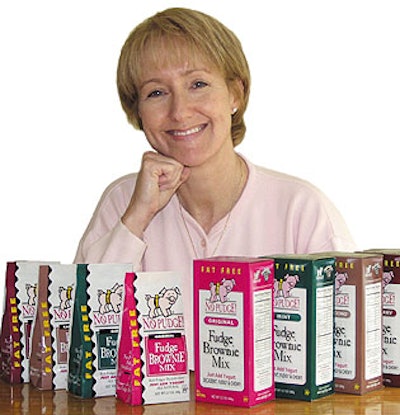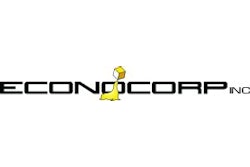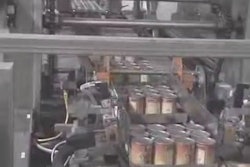The exasperation in Lindsay Frucci’s voice is palpable as she describes the hurdles her company, No Pudge! Foods, overcame in sourcing packaging materials for its natural, fat-free brownie mixes. Frucci, the company’s founder and president, relates that most of the problems had to do with leakage attributable to the paper/plastic bags the company used previously and the long lead times to receive shipments of those bags. In April, the two-person Hopkinton, NH-based company eliminated those problems by switching to a folding carton with an inner bag.
The inner bag, a 2-mil lamination of polyester and linear low-density polyethylene, is from Union Industries (Providence, RI). The bag is packed into an outer paperboard folding carton whose unusual size and graphics provide differentiation from typical brownie mix boxes. The 18-pt clay-coated newsback folding carton, from Keystone Paper & Box (East Windsor, CT), is printed offset in five colors, plus an aqueous coating.
No Pudge! supplies the mix recipe to Concord Foods (Brockton, MA) for contract manufacturing and packaging. Concord fills the bags on vertical form/fill/seal equipment, then packs the bag into a carton, using a new cartoner from Econocorp (Randolph, MA). Concord is best known as a manufacturer of products sold in the produce departments of supermarkets in the United States, Canada, and Mexico. However, it does a limited amount of contract packaging and has served as a CP for No Pudge! since the latter firm launched its original Fudge Brownie Mix in 1995.
Switching to a carton
Initially, distribution of that mix was limited to two stores in New Hampshire. While No Pudge! believed it had a marketable product—an all-natural mix that requires the consumer to add only yogurt before baking—it ran into an incredible string of bad luck concerning its packaging materials (see sidebar, p. 25).
In fact, the company bought from three different bag vendors before switching to the new pack. Its current suppliers are expected to help No Pudge! reach seven-figure sales for its four 13.7-oz brownie mix varieties. Each $2.99 package carries a one-year shelf life.
No Pudge!’s misfortunes with the bags, and their vendors, was one of two factors that led the company to switch to a bag-in-box package. The second factor was in-store handling. “We learned that the stand-up bags just don’t stand up well to the retail market,” explains Frucci. She says that during distribution, the bags tended to get squashed. In an ideal retail environment, a clerk would straighten out each bag before placing it on a shelf. But Frucci knows there usually isn’t time for that.
“People stocking the shelves don’t use care when unloading a case,” she comments. “They grab it and stuff as many packs as they can on a shelf so that they don’t have to go back and restock more bags. Every time I’d go into a grocery store that carried our product, I’d be straightening the bags,” she adds. “The bags wore out after a while, they looked squashed, and there were often smears of ink on them.” These smears were due to problems that sometimes occurred during heat sealing, as described in the sidebar.
The unappealing or leaking bags not only limited sales, but also led to increases in what Frucci defines as “reclamation, or returns from distributors and stores. That led us to using a carton,” she explains.
Unusual carton size
But No Pudge! didn’t want to move into the traditional brownie/baking mix box that’s still prevalent on shelves today. “We’re a niche product, and I want us to stay that way,” Frucci states. She also knew that if the product switched from a 3½”-wide bag to a standard 5”-wide carton, “we’d lose shelf facings. We’re too small to afford that. And we’ve fought too hard for every inch of shelf space. We needed a unique box size.”
Fortune began to smile on No Pudge! when it sought suppliers for the new pack. Frucci’s husband, Paul, unexpectedly met an old college friend at a highway rest stop. Turns out the friend worked for a box/carton producer in Connecticut, Keystone Paper & Box. “This company is a ‘first-class’ supplier, and the antithesis of what I ran into with the bag companies,” says Frucci. “They jumped through hoops for us.” And they provided No Pudge! with the unique carton it sought. It measures 3½” wide x 7½” high x 2½” deep.
Keystone ships carton blanks to contract packager Concord Foods, which uses a cartoner from Econocorp to pack filled bags of the mix into cartons. Purchased for the No Pudge! application, the machine is equipped to accommodate the unusual carton size.
Rated at 20 carton/min speeds for the application, the Econocorp E-System 2000 is a portable cartoner. It includes a bucket conveyor to transport bags of the mix, an automatic product inserter, a unit that seals the carton ends with hot melt, and a debossing coder that delivers a production and lot code.
“Concord is like a partner to us in that they’ve been with us since day one and they serve somewhat as a mentor to us, offering constant help and advice,” says Frucci. “They also handle product warehousing and distribution for us. They’ve stuck with us throughout the years, and they’ve seen our business grow, even though we only sell the brownie mixes.”
‘Fun’ graphics
Despite the hurdles it faced regarding packaging materials, No Pudge! is on track to reach the $1 million mark in sales this year. “We’ve regained the confidence of our distributors and stores,” she gladly reports. “And packaging has played a huge role in that. The new box is wonderful.”
Frucci credits friend and graphic artist Lee Morrill with creating the graphics that, along with size and shape, make the carton easily recognizable among competitive brownie packs. Morrill is the sole proprietor of On Track Design (New London, NH).
Rather than show a photo of the finished product, as do cartons used for many of the leading brownie mixes, No Pudge! relies on a drawing of a smiling pink pig with a tape measure around its modest waistline.
“My husband, Paul, and I brainstormed about the company and concept, and he came up with the logo,” recalls Frucci. “I told Lee Morrill to keep it fun, light-hearted, and colorful.” The cartons rely on colors to indicate flavors, using a dark red for raspberry fudge brownie mix, green for mint, etc.
There’s also a bit of fun on the carton’s back panel, courtesy of Frucci, whose signature follows a one-paragraph product description that opens with her confession, “I am a brownieholic.”
A side panel, “No Pudge! Notes,” provides high-altitude baking instructions, a message for the lactose intolerant, and a single-serving microwave recipe for consumers who don’t want to use the entire 13.7 oz of mix to make a full pan of the goodies. Frucci admits the package is not designed for resealing, though that would be impractical because the entire mix is meant to be used. It would also be cost-prohibitive.
Packaging World noticed another interesting graphic on one of the carton’s side panels. Just above the Nutrition Facts panel are two company logos, one from No Pudge!, the other from organic yogurt producer Stonyfield Farm. Beneath the logos is a line of type that reads, “Two New Hampshire companies partnering for better health!”
Not only are the two companies located near each other, but Frucci also lives near one of Stonyfield’s top executives and is friends with other key management personnel from that company. There’s a natural product tie-in because the brownie mixes require consumers to add yogurt.
“There was an obvious connection between our companies,” says Frucci. “But I didn’t want to approach their company about doing anything together until we had product distribution that was somewhat close to Stonyfield’s in certain areas. I wanted to come in and be able to offer something to them, too. There’s no money involved, but having their logo on our cartons boosts our credibility and promotes their products.
“We have a following of weight watchers that’s significant and growing, and this gives Stonyfield an ‘in’ to that group of consumers who may see the logo and reach for Stonyfield yogurt, while they may not have done so before,” she believes. “We also plan to do some store-level demos with them and cross-couponing, where if you buy the mix, you get a free yogurt, or vice-versa.”
Stonyfield prides itself on using “environmentally friendly” packaging materials. Asked if No Pudge! planned to switch to recycled material for its cartons, Frucci said, “not at this point because they’re too expensive. We’re trying to cut costs, and our margins don’t leave enough profit to afford that luxury, though recycled board is certainly something we’d like to use.”
The next step, she says, will be to introduce a line of fat-free muffin mixes, which she expects to do later this year. For that launch, Frucci suggests the company will likely use more “neon-like” colors. However, the same carton style will be used.
Looking back on its first six years, particularly in sourcing packaging materials, Frucci admits, “I’ve learned a lot about packaging. Probably the toughest part of setting up this company was finding the right contract packager. I’m still pleased that Concord Foods took us on. They believed in us.”
No Pudge! now believes in its suppliers and materials, which have helped the company better its package while holding the line on costs. “It’s amazing,” she relates, “that we’ve gone from this problematic, horrendous situation with bags that were actually more expensive” than the new combination of bag and box.
The comparison is somewhat detailed, but essentially she says the inner pouch is “absorbed” into Concord’s manufacturing cost, which she says is reduced due to the faster and more efficient equipment that runs the new materials. Then there’s a 2¢-per-pack savings for the new carton compared to the previous paper/plastic bag. “No matter how you figure the math, it still is cheaper for us now. Our production costs have gone down, not a lot, but they’ve gone down. And that’s very important to us.”
See sidebar to this article: No Pudge! leaps materials hurdles






























